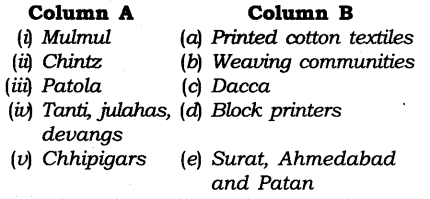EVENTS CONVENT HIGH SCHOOL
12/02/2022 CLASS- 8 SESSION 2021-22
SUBJECT : SOCIAL SCIENCE
CHAPTER-7
Weavers, Iron Smelters and Factory Owners,
______________________________________
Question 1.Choose the correct option:
(i) One of the most important Indian ports of the 17th century.
(a) Bombay
(b) Madras
(c) Surat
(d) Vishakhapatnam
(ii) Bandana patterns were mostly produced in
(a) Rajasthan and Gujarat
(b) Rajasthan and Orissa
(c) Rajasthan and Madhya Pradesh
(d) Chhattisgarh and West Bengal
(iii) The job of a rangrez was to
(a) Weave cloth
(b) Dye thread
(c) Transport goods to. the markets
(d) Spin thread on the charkha
(iv) The first cotton mill in India was established in
(a) Gujarat
(b) Bombay
(c) Madras
(d) West Bengal
(v) Wootz steel was produced all over
(a) South India
(b) North India
(c) Central India
(d) North-east India
Answer:
(i)(c), (ii)(a), (iii)(b), (iv)(b), (v)(a)
Question 2.
Fill in the blanks with appropriate words to complete each sentence.
- The cotton textiles which the Portuguese took back to Europe, along with the spices came to be known as …………..
- The …………….. was invented by John Kaye which increased the of the traditional spindles.
- Weavers often belonged to communities that specialized in ……………..
- ………….. and ………………. emerged as important new centres of weaving in the late 19th century.
- Indian Wootz steel fascinated ………………. scientists.
- The Tata Iron and Steel factory is situated on the banks of the river …………..
- TISCO had to expand its capacity and extend the size of its factory to meet the demands of the …………..
Answer:
- Calico
- Spinning Jenny
- weaving
- Sholapur; Madurai
- European
- Subamarekha
- war
Question 3.
State whether each of the following statements is True or False.
- From the 1850s, Britain came to be known as the ‘workshop of the world’.
- The invention of the spinning jenny and steam engine revolutionized cotton textile weaving in England.
- European trading companies such as the Dutch, the French, and the English purchased cotton and silk textiles in India by importing diamonds.
- Men were usually involved in the work of spinning.
- Iron smelting in India was extremely common until the end of the 19th century.
- The Tata Iron and Steel Company began to produce steel after the First World War.
Answer:
- True
- True
- False
- False
- True
- False
Question 4.
Match the items given in Column A correctly with those given in Column B.
Answer:
(i) (c), (ii) (a), (iii) (e), (iv) (b), (v) (d)
Class 8 History Chapter 7 Weavers, Iron Smelters and Factory Owners Very Short Answer Type Questions
Question 1.
Give two reasons why Indian textiles were renowned all over the world.
Answer:
Their fine quality and beautiful craftsmanship made them renowned all over the world.
Question 2.
Why were printed Indian cotton textiles I popular in England?
Answer:
Printed Indian cotton textiles were popular in England for their exquisite floral designs, fine texture and relative cheapness.
Question 3.
During which period patola weaving was famous?
Answer:
It was famous during the mid-19th century.
Question 4.
Name the origin of the word calico.
Answer:
Calicut.
Short Answer Type Questions
Question 1.
How were Indian textiles viewed in the world market?
Answer:
India was the largest producer of cotton textiles in the world before the British conquered Bengal around 1750. Indian textiles had long been renowned both for their fine quality and exquisite craftsmanship. They were extensively traded in Southeast Asia (Java, Sumatra, and Penang) and West and Central Asia. From the 16th-century European trading companies began buying Indian textiles for sale in Europe.
Question 2.
How did the inventions of the Spinning Jenny and Steam Engine revolutionise cotton textile weaving in England?
Answer:
Textile industries had just emerged in England in the early 18th century.
So, it was difficult for the English producers to compete with Indian textiles. This competition with Indian textiles led to a search for technological innovation in England. In 1764, the Spinning Jenny was invented by John Kaye which increased the productivity of the traditional spindles.
Then came the steam engine. It was invented by Richard Arkwright in 1786. These two inventions revolutionised cotton textile weaving in England. Cloth could now be woven in immense quantities and cheaply too.
Question 3.
Give a description of the four regions where textile production was concen¬trated in the early 19th century.
Answer:
Textile production was concentrated in the following four regions in the early 19th century:
- Bengal was one of the most important centres. Located along the numerous rivers in the delta, the production centres in Bengal could easily transport goods to distant places.
- Dacca in Eastern Bengal, present-day Bangladesh, was the foremost textile centre in the 18th century. It was famous for its mulmut and jamdani weaving.
- Textile production was concentrated along the Coromandal coast stretching from Madras to northern Andhra Pradesh.
- On the west coast there were important weaving centres in Gujarat.

